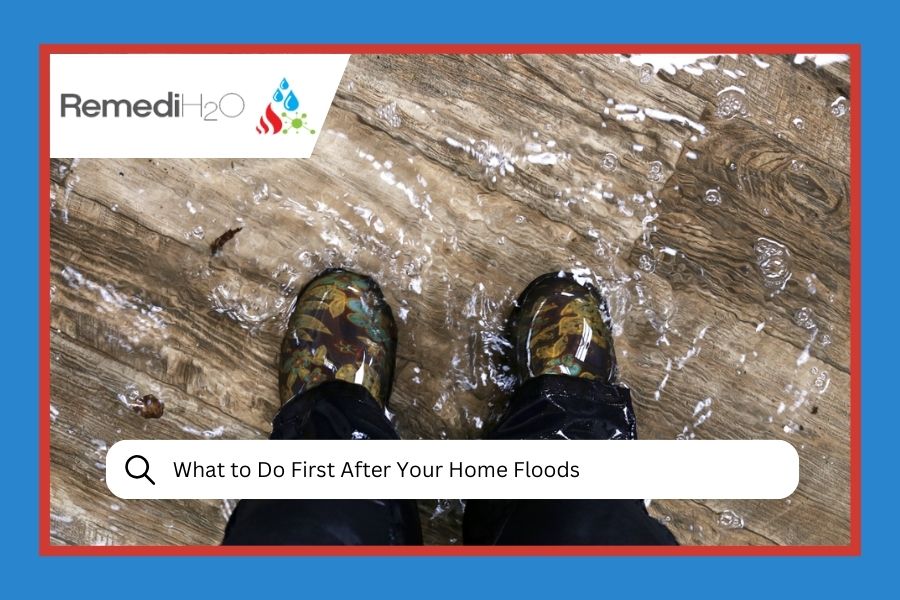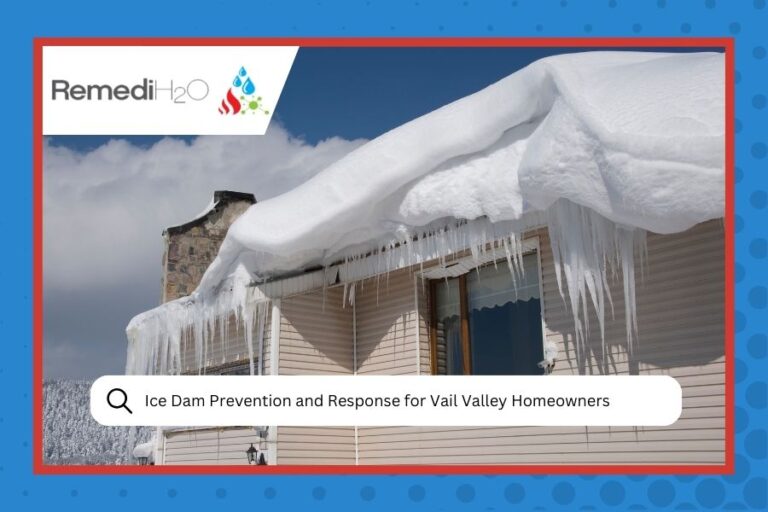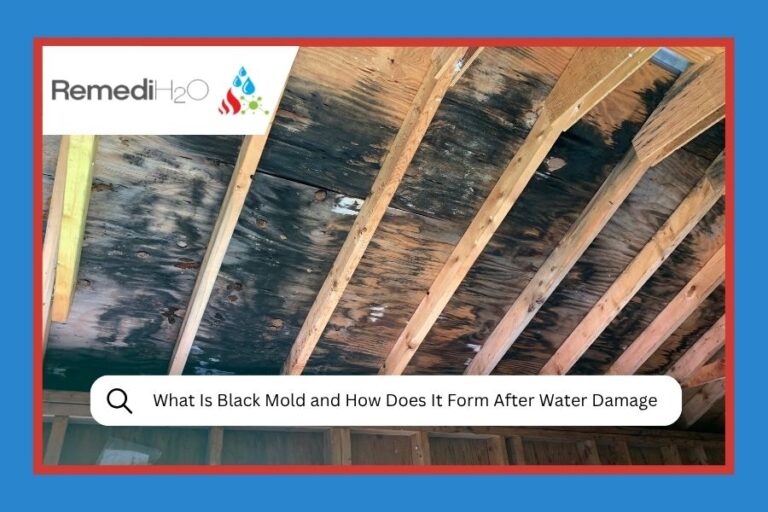Jump to Section:
When you walk into your home and hear that awful squish under your feet, your heart probably drops faster than a roller coaster at Glenwood Caverns. We get it, flooding is one of those disasters that makes you feel completely helpless. But here’s the thing: what you do in those first few hours can make the difference between a manageable cleanup and a months-long nightmare.
We’ve been helping folks across Colorado’s Western Slope and Roaring Fork Valley deal with these exact situations for years, and trust us when we say that taking the right steps immediately can save you thousands of dollars and weeks of headache. Let’s walk through this together, because nobody should have to face flood cleanup alone. Our water damage restoration team has seen it all, from burst pipes in Aspen to basement floods in Silt, and we’re here to guide you through the chaos.
Step 1: Prioritize Safety Above All Else
Before you even think about assessing damage or grabbing that mop, you need to make sure everyone in your household is safe. Floodwater isn’t just dirty water, it can be downright dangerous.
🚨 Immediate Safety Checklist
⚡ Electrical Safety
Turn off electricity at main breaker if water reached outlets
🏗️ Structural Check
Look for sagging ceilings or compromised support beams
👥 Head Count
Ensure everyone is accounted for and in a safe, dry area
💨 Gas Safety
If you smell gas, leave immediately and call utility company
Remember, Colorado’s high altitude can make some situations more challenging. The thinner air means you’ll get tired faster, and if you’re dealing with contaminated water, respiratory issues can hit harder up here.
Here’s something we learned from years of emergency calls: take photos of everything before you start cleanup, even if it’s hard to see through all that water and mess. Your insurance company will thank you later, and it helps us understand exactly what we’re dealing with when you call for help. For more detailed guidance on emergency response, check out our guide on how to stop water damage in 7 emergency steps.
Step 2: Stop the Water Source (If Possible)
This might seem obvious, but you’d be surprised how many people focus on cleaning up water without stopping the source first. It’s like trying to fill a bucket with a hole in it.
Common water sources and how to address them:
Burst Pipes or Plumbing Issues
- Locate your main water shutoff valve (usually near where the water line enters your home)
- Turn off individual fixture valves if you can identify the specific source
- Contact a plumber immediately for repairs
Appliance Malfunctions
- Unplug the appliance if it’s safe to do so
- Turn off water supply lines to washing machines, dishwashers, or water heaters
- Move items away from the leaking appliance
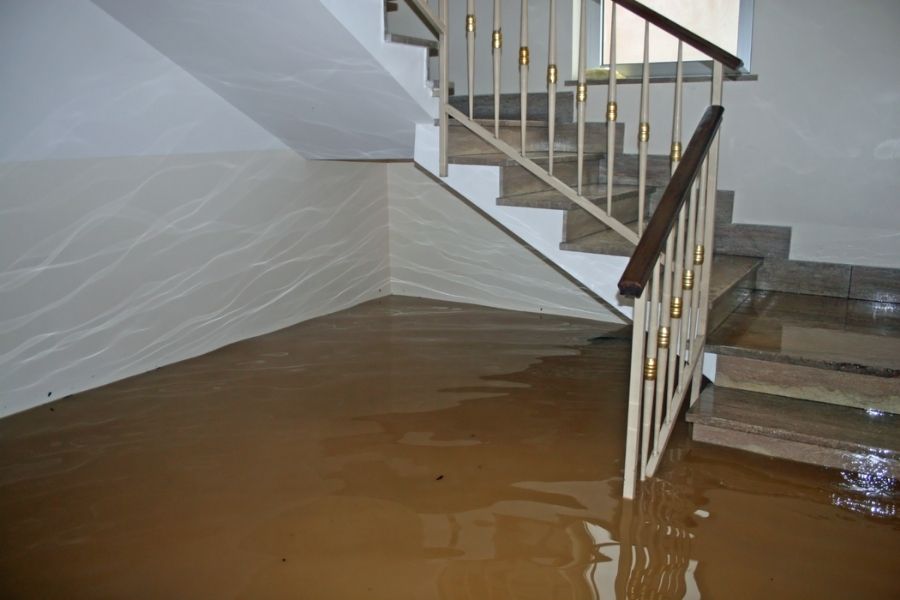
Basement flooding is common in Colorado homes due to snowmelt and rapid temperature changes. Acting quickly to identify and stop the water source can prevent extensive damage like what’s shown here.
Natural Flooding from Rain or Snowmelt
- There’s not much you can do to stop Mother Nature, but you can prevent additional water from entering
- Place sandbags or barriers at entry points if water is still rising
- Clear blocked gutters and drains if safely accessible
Living in Colorado means dealing with unique challenges like rapid snowmelt in spring and sudden thunderstorms in summer. These aren’t just minor inconveniences, they can turn into major flooding events faster than you can say “fourteener.”
Ready to Get Professional Help?
Don’t tackle flood cleanup alone. Our certified team at RemediH2O provides 24/7 emergency response across Colorado’s Western Slope. We’ll handle everything from water extraction to complete restoration, working directly with your insurance company to make the process as stress-free as possible.
Step 3: Document Everything for Insurance
Before you start moving things around or cleaning up, grab your phone and start taking pictures. This documentation will be crucial for your insurance claim and helps restoration professionals like us understand the full scope of damage.
What to document:
- Wide shots showing the extent of flooding
- Close-ups of damaged items, floors, walls, and furniture
- Water level marks on walls
- Any structural damage you notice
- Serial numbers and brands of damaged appliances
- Time-stamped photos showing the progression of damage
Make a written inventory too. Yes, it’s tedious when you’re stressed, but insurance companies love detailed lists. Include purchase dates and approximate values when possible. If you’re wondering about coverage specifics, our article on what is water damage restoration and does insurance cover it in Colorado breaks down the details.
Step 4: Begin Water Removal and Drying
Now comes the physically demanding part. The goal here isn’t to get everything perfect, it’s to remove as much standing water as possible and start the drying process to prevent mold growth.
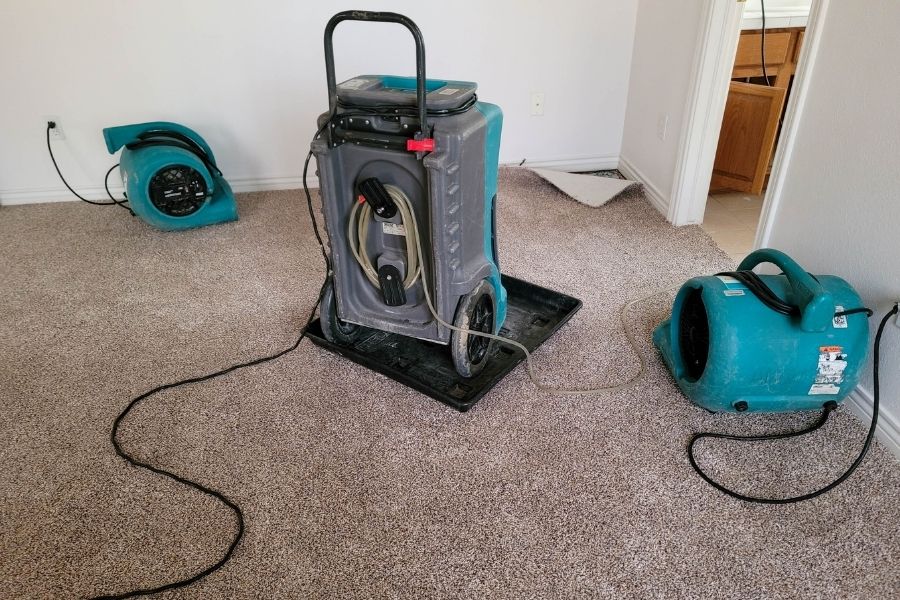
Professional drying equipment like industrial dehumidifiers and air movers are essential for thorough water removal. Colorado’s dry climate helps, but proper equipment ensures complete moisture elimination.
DIY water removal methods:
- Use a wet/dry vacuum for smaller amounts of water
- Mop and bucket for shallow standing water
- Towels and rags for surface water
- Open windows and doors to increase air circulation (weather permitting)
- Set up fans to promote air movement
When to call professionals immediately:
- More than a few inches of standing water
- Water has been present for more than 24-48 hours
- You suspect sewage contamination
- Structural damage is visible
- You’re feeling overwhelmed (this is totally normal!)
Here in Colorado, our dry climate can actually work in your favor during the drying process, but don’t let that fool you into thinking mold won’t grow. At higher altitudes, temperature swings can create condensation issues that promote mold growth in unexpected places.
Step 5: Salvage What You Can
Not everything touched by water is automatically ruined, but you need to act fast. The longer items stay wet, the less likely they are to be saved.
| Can Often Be Saved | Usually Total Losses |
|---|---|
| Hard surfaces: Concrete, tile, sealed wood with quick action | Particle board furniture: Swells and falls apart when wet |
| Metal items: Appliances, tools (if dried and treated quickly) | Drywall: Especially if wet for more than 48 hours |
| Some fabrics: Synthetic materials often fare better | Carpeting and padding: Particularly if contaminated water involved |
| Non-porous items: Dishes, glassware, most toys | Paper documents: Though some can be freeze-dried professionally |
Quick Salvage Tips:
- Remove wet items from the area to prevent further damage
- Don’t try to plug in electronics until they’ve been professionally evaluated
- Rinse items affected by contaminated water with clean water
- Remove excess moisture but don’t attempt to force-dry delicate items
Essential Safety Gear and Supplies Checklist
Living in Colorado means being prepared for mountain weather, but flood cleanup requires some specific gear you might not have on hand:
Personal Protection:
- Waterproof boots or waders
- Rubber gloves (heavy duty)
- N95 masks or better for mold protection
- Eye protection
- Long pants and sleeves
Cleanup Supplies:
- Wet/dry vacuum with extra filters
- Industrial fans (rent if necessary)
- Dehumidifier
- Disinfectant solutions
- Trash bags and containers
- Tarps for protecting items
- Battery-powered or portable lighting
Pro tip: Colorado’s high altitude can make you more susceptible to fatigue and dehydration. Take breaks often, drink plenty of water, and don’t try to be a hero. We’ve seen too many people exhaust themselves during cleanup and end up needing medical attention.
Understanding Colorado’s Unique Flood Challenges
Living on the Western Slope comes with some specific flooding scenarios you won’t find in other parts of the country:
Rapid Snowmelt Flooding
Spring warming combined with sudden temperature spikes can create massive runoff. Unlike gradual flooding, snowmelt floods can happen incredibly fast, giving you little time to prepare.
High-Altitude Thunderstorms
Summer storms in the mountains can be intense but brief, creating flash flood conditions in creek beds and low-lying areas. The rocky terrain means water doesn’t absorb quickly, leading to rapid runoff.
Frozen Pipe Scenarios
Our temperature swings mean pipes can freeze and burst without warning. When they thaw, you might not discover the damage until water has been flowing for hours or even days.
Unique Structural Considerations
Many homes in our area are built on slopes or have basement levels that make water removal more challenging. Understanding how water flows in your specific situation is crucial for effective cleanup.
When Professional Help Becomes Essential
Look, we know everyone wants to save money, especially after a disaster has already hit your wallet hard. But there are times when calling professionals isn’t just recommended, it’s necessary for your safety and your home’s long-term integrity.
Call professionals immediately if:
- Standing water is more than 2 inches deep throughout the home
- You suspect sewage contamination
- Electrical systems have been compromised
- Structural damage is visible
- Mold growth is already apparent
- You’re dealing with water that’s been present for more than 48 hours
Our mold remediation team at RemediH2O specializes in the unique challenges of high-altitude flood cleanup. We understand how Colorado’s climate affects drying times, what building materials are common in our area, and how to work with local insurance providers who understand regional flooding patterns.
We’ve been doing this for over 25 years combined, and here’s what we’ve learned: the families who call for professional help early almost always end up spending less money and getting back to normal faster than those who try to handle everything themselves first. Want to see how this plays out in real life? Read about when water damage strikes a Glenwood Springs home’s recovery story to understand the complete restoration process.
Creating Your Emergency Response Plan
Here’s the reality: if you’re reading this after a flood has already happened, this information might feel like too little, too late. But once you get through this crisis, take some time to create an emergency response plan for next time.
Your Colorado Flood Emergency Kit Should Include:
- Emergency contact numbers (including local restoration companies)
- Location of main water shutoff valve
- Insurance policy information and photos of your home pre-disaster
- Battery-powered radio and flashlights
- First aid supplies
- Emergency cash (ATMs might not work during widespread flooding)
- Important documents in waterproof containers
Family Emergency Plan:
- Designated meeting places if you need to evacuate
- Communication plan if cell towers are affected
- Emergency contacts outside the immediate area
- Plans for pets and livestock
- Know your evacuation routes (especially important in mountain communities where roads can be limited)
Remember, flooding in Colorado isn’t always a slow-rising river situation. Flash floods in mountain communities can happen with little warning, so having a plan ready can literally save lives.
The bottom line is this: floods are awful, but they’re not the end of the world. With the right response, good documentation, and professional help when needed, you can get through this. We’ve helped hundreds of families throughout Silt, CO and the surrounding Western Slope region get back on their feet after flooding disasters.
Take it one step at a time, prioritize safety, and don’t hesitate to ask for help. That’s what we’re here for.
Frequently Asked Questions
How quickly do I need to start cleanup after flooding in Colorado’s mountain climate?
You need to start water removal within 24-48 hours, but Colorado’s high altitude and dry climate create unique challenges. The temperature swings we experience can actually accelerate mold growth in unexpected ways. Even though our air is dry, condensation from rapid temperature changes can create perfect conditions for mold in hidden spaces like behind walls or under flooring.
Should I attempt DIY water removal in a basement flood, or call professionals right away?
For basement flooding in our area, professional help is usually necessary because many Western Slope homes have complex drainage issues due to slope construction and rocky soil conditions. If you have more than 2 inches of standing water or if the water has been present for over 24 hours, don’t risk it. The structural challenges of mountain home construction make DIY cleanup risky.
What makes flood cleanup different at high altitude compared to other regions?
High altitude affects both you and the cleanup process. You’ll tire faster due to thinner air, making physical cleanup more exhausting. The rapid weather changes in mountain areas also mean what starts as a small leak can quickly become major flooding when temperatures swing. Plus, our rocky soil means water doesn’t absorb naturally, so it tends to pool and create more extensive damage.
How do I know if my flood water is contaminated in a rural Colorado setting?
In rural areas of the Western Slope, flood water often carries agricultural runoff, septic system overflow, or debris from mining areas. If your flood water has any color, odor, or visible debris, treat it as contaminated. Even clear water can be dangerous if it’s come from outside sources or has been sitting for more than 48 hours in our variable temperature conditions.
Looking for more helpful content about protecting your home? Learn more about professional fire damage restoration services and get expert tips on winter weather preparation. And remember, our team is always here to help when disaster strikes, with 24/7 emergency response throughout Colorado’s Western Slope and Roaring Fork Valley.
